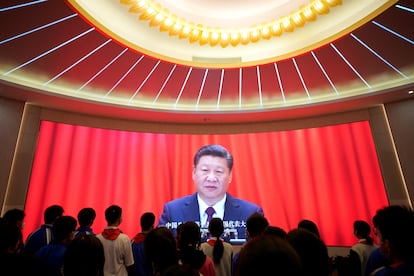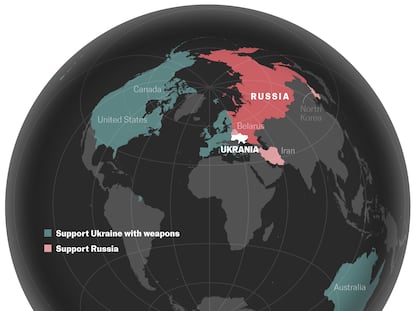The world’s powers are engaged in a fierce technological race. This is the balance of forces
The US struggles to retain its supremacy, China catches up and overtakes the leader in many areas while the EU is falling behind

Huge investments, sanctions, protectionism, espionage, new regulatory frameworks, international alliances, threats: the world’s major powers are battling in an increasingly fierce technological race that encompasses key sectors such as artificial intelligence, quantum computing, biotechnologies, clean energy, aerospace and telecommunications, and which is becoming the main area of strategic competition of our time.
The month of March has offered significant glimpses of the scope and characteristics of this battle with far-reaching consequences for the global balance of power, in which the United States is struggling to maintain its supremacy, China is advancing strongly, while multiple signs indicate that the European Union is lagging behind. “Western democracies are losing out in the global technology competition,” concluded a study published on 2 February by the Australian Strategic Policy Institute (ASPI), highlighting China’s rise in the research segment in technology sectors of particular interest.
That same day, Joe Biden’s Administration added a new handful of Chinese companies to the black list of entities subject to limits on the export of sensitive technology, among them units of the genetic sector giant BGI, in a new step in the escalation of restrictive measures that Washington has been applying against Beijing, while at the same time promoting huge subsidies to develop national capabilities.
On the 6th, Chinese President Xi Jinping expressed the Asian power’s irritation with this policy with a very striking accusation, as it consisted of an explicit statement that was alien to the leader’s style: “Western countries, led by the United States, are implementing a containment, encirclement and total suppression of China”. The next day, his new foreign minister, Qin Gang, made it even clearer: “If the United States does not step on the brakes and continues to accelerate on the wrong track, there will not be enough guardrails to prevent the derailment, which will turn into conflict and confrontation”.
On the 9th, the European Commission announced a new relaxation of state aid rules to respond to Washington’s subsidies and compete with them. And on the 10th, US President Joe Biden and EU Chief Executive Ursula von der Leyen met in Washington to address the friction between the partners over protectionist aspects of their national green technology promotion plans. Hours earlier, in Beijing, the Communist Party (CCP) announced a major reorganization of the Ministry of Science and Technology and the establishment of a National Data Office.
These recent anecdotes clearly trace the contours of a pivotal career. Technological progress is the essential foundation for the economic prosperity and military might of societies, as it is for political stability in the face of external subversive attempts. Historically, therefore, it has been a decisive factor in determining the balance of power between nations, and today it is more so than ever, in view of the dizzying pace, breadth and significance of innovation in strategic sectors.
The following is a look at the current balance of power and how the battle for the future is being fought.
Current balance of powers
Studies and pronouncements by industry experts outline an area of consensus that can be summarized as follows: The United States comes from decades of total supremacy and retains a dominant position in key sectors; however, the Chinese boom is extremely strong, has been closing the gap at a great pace, in some cases overtaking Washington and in others already positioning itself as a competitor on a par; the European Union has significant assets, but barring a major change in dynamics, it will be substantially left behind.
“The US still has an advantage in some mature technologies. It pioneered the digital revolution and that still carries weight today. Its massive and prolonged push in the defense industry means that it remains a leader in military technology,” says Pannier.
The world’s leading power has leading companies not only in the digital and defense sectors, but also in biotechnology and other areas. It also has universities and laboratories with global appeal, high levels of investment, a market environment conducive to innovation and a wide network of international alliances.
But many indicators point to a very strong Beijing boom. “Looking at the big picture, I think the US and China are in a similar position in terms of capabilities,” says Raquel Jorge Ricart, a researcher at the Elcano Royal Institute specializing in the technology and digital agenda. “Each technological area has its balance. But I believe that they are currently in a situation of a tie and that the trend, if not reversed along the way, leads to the technological supremacy of China and that the EU could be left far behind,” the expert thinks.
“China has been able to rise to levels of global relevance in multiple sectors. It is a leader in surveillance and the use of artificial intelligence in public spaces. In the digital environment it has also made a huge leap, and is now a competitor that threatens the primacy of the United States,” says Pannier.
Beijing’s list of strengths is long. For example, it is clearly ahead of the United States in the deployment of 5G - with two European companies, Ericsson and Nokia, as its main competitors, which, says Jorge Ricart, “need more public support”.
Ben Cahill, senior research fellow at the Center for Strategic International Studies, an expert on energy security, highlights how “China plays a critical role in the clean energy transition because it manufactures a lot things that are essential to it, and operates at such a huge scale that it’s dominating certain parts of the clean energy supply chains, for example in wind, solar and batteries”. “The problem is the West can’t erase this dependency overnight. The Chinese have been building this advantage for decades” he adds.
Cahill points to another key segment where China has a dominant position: “Critical minerals are a fundamental issue,” he says during a conversation this week in Madrid. “The problem is not so much where they are found, because they are found in many places, but the processing and refining capabilities that make them useful, and that is where China has a dominant position. This is not going to change suddenly. It is a long-term project. It will require a prolonged effort of decades.”
A report from Harvard University’s Belfer Center concludes that China has already overtaken the United States in quantum communication, and has rapidly reduced the US lead in quantum computing.
Even in the critical defense sector there are some specific areas, such as hypersonic weapons, where China has the edge, US leaders acknowledge.
The recently published ASPI report - funded by the US State Department - focuses on a very important parameter, the publication of influential studies in 44 critical technology sectors, considering in each of them the decile of most referenced publications. The result is that China has the lead in 37 of the 44 sections, with the United States dominating the other seven. Among the European countries, the United Kingdom, Germany and, to a lesser extent, Italy and France stand out. Among the Asian countries, India, Japan and South Korea. But all of them are a long way behind the two titans.
Of course, the interest of published research is not synonymous with technological power. For that, the translation to real life is essential. But it is clear that research is the basis on which this power is built, that the most referenced publications are those that tend to give rise to patents, and that patents usually lead to industrial manufacturing. The report also studies the flow of researchers and concludes that Chinese centers attract a significant number of people from other countries.
There are many indicators that corroborate China’s powerful rise, such as investment in R&D - in which, according to OECD comparisons, it has already surpassed the EU - or the strength of the group of companies with the greatest research vitality. According to a count by the European Commission, 27% of the 2,500 companies with the highest investment in R&D are Chinese, almost double that of the EU. In absolute values, investment is similar. The United States retains supremacy on these indicators. But the trend in China’s favor seems inexorable.
An estimate published by the US Foundation for Innovation and Information Technology also reflects the enormous Chinese rise, concluding that in absolute values, China already has a greater innovative potential than the US, using as parameters investment in R&D, venture capital, human capital and patents.
In this scenario, the EU is emerging as a second-tier player. “Europe has remarkable capabilities in some niches. For example in semiconductor design machines, 5G equipment or in some areas of software design,” says Pannier. There are other areas where Europe has players that compete superbly on a global scale.
“But, in an overall look, you can’t compare with the two giants, it’s a bit painful,” Pannier concludes.
There are of course other significant players. Countries such as Japan or South Korea have significant technological strengths. But, as Jorge Ricart points out, their sectoral capabilities have no prospect of translating into systemic competitiveness due to their lack of size. India is beginning to have significant capabilities. It has the dimensions to become a systemic player in the future. The United States’ suspicion of China may help it, for example, by attracting Western technology companies to set up in its territory to strengthen its manufacturing and local labor capabilities. However, it still has a long way to go to compete on a par with the major players at the same level.
How the battle is fought
Faced with this ratio of strength in capabilities, the powers are engaged in a great competition to position themselves well for the future. This has different axes.
“One of the key trends is the major public push for industrialization in sensitive areas with the activation of huge subsidies,” says Jorge Ricart. The renewed activism in this sector in most Western democracies is undoubtedly a central defining feature.
While China has long been developing - and especially since 2015, with the launch of the Made in China 2025 plan - powerful public policies aimed at developing its technological strength, Western countries had largely left this work in the hands of private companies and institutions, limiting themselves to taking care of conducive research and market frameworks. However, several factors have spurred a radical shift.
The realization of China’s rise prompted the United States to react to preserve its advantageous position more than a decade ago, with the pivot to Asia promoted by then President Barack Obama. “But then other elements made what was a bilateral rivalry centered on technology relevant to military and economic ascendancy assume a more global relevance,” Pannier says.
“In the past decade China has greatly developed its technology sector, with digital, surveillance, artificial intelligence capabilities that have astonished the world, while, in parallel, it was becoming an increasingly authoritarian regime. This spurs a reflection on China’s dependence. A key moment in this new global phase is when, prior to the pandemic, the United States acted to halt the deployment of Huawei’s 5G technology, pointing out possible security risks,” continues the expert.
“Then the pandemic itself highlighted the risk of supply chain disruption, which can have political or natural reasons, and this helps to convince many of the need to reindustrialize so as not to be so dependent,” notes Pannier. This chain of events leads to a Western reaction, very strong in the case of the United States, but also notable in the case of the EU.
The EU has also been active in this investment race. A significant part of the pandemic funds financed by joint borrowing are earmarked for green and digital investments, while Brussels has launched a microchip initiative and is developing others in the green technology sector. Certain US provisions of a markedly protectionist nature, which threaten to discriminate against European products, have led to serious tensions between Washington and Brussels.

Other major economies, of course, are also moving with increasing intensity to support the development of national technological capabilities.
Hand in hand with the domestic drive goes another major line of action. “A second key trend is the reorganization of global supply chains,” observes Jorge Ricart. Among other things, this involves relocating the manufacture of sensitive products and components as well as consolidating the supply routes for the raw materials needed for technological developments. It is a big game that involves reformulating relations with relevant countries from a mining or manufacturing point of view.
The Biden Administration is vigorously pushing for a broad disengagement from China, although a complete disengagement is unfeasible, while in the EU, for the time being, the majority consensus opts for the more prudent concept of risk reduction. Both have been active in reducing China’s dependence on raw materials, and Biden and Von der Leyen announced after their meeting that the two sides will work on a free trade agreement limited to this sector that aims, among other things, to reduce European anger at US protectionist measures.
There is also a third, and most controversial, area of contention, namely the restrictions on China’s access to key technologies being promoted by Washington. The operation has focused mainly on the microchip sector, essential for progress in many of the strategic areas identified, and is conveniently designed to prevent exports to China even by foreign companies when the product in question has a US material or intellectual component, as is often the case in advanced microchips.
Washington maintains that these measures are intended to “protect national security and prevent sensitive technologies with military applications from being obtained by China’s security, intelligence and military services,” according to US Deputy Secretary of Commerce Alan Estevez, on the occasion of the approval of the restrictions on microchip exports.
“China is investing heavily to develop supercomputing capabilities and become a world leader in artificial intelligence by 2030. It uses these capabilities to monitor its own citizenry and drive its military modernization. Our actions will protect national security, foreign policy interests, while sending a clear message that US technological leadership is about values as well as innovation,” said Thea D. Rozman Kendler, also a senior Commerce Department official.
The White House is also pushing for allied countries with high technological capacity to join its maneuver to multiply efficiency, and for example, the Netherlands and Japan, states with key companies in the sector, have indicated their willingness to support the restrictive policy.
In the face of Washington’s arguments, as Xi Jinping himself states, Beijing sees only an indiscriminate attempt to contain its country’s rise. In these circumstances, the CCP is reinforcing an increasingly centralized technological and industrial policy response. Among the decisions announced Friday is a reconfiguration of the Ministry of Science and Technology to boost its scope and focus it on high-tech issues. A science and technology committee under party control will be instituted in the ministry, and a National Data Office will also be instituted. Public support for increasing autonomy in microchip matters is absolute.
In addition to these three very muscular and obvious axes, there are others, such as the drive to favorably shape international norms and standards in sensitive areas, to achieve the cooperation of as many countries as possible throughout the sensitive chain in the face of adversaries, and to attract talent.
The outcome of this competition will fundamentally shape the 21st century.
Sign up for our weekly newsletter to get more English-language news coverage from EL PAÍS USA Edition
Tu suscripción se está usando en otro dispositivo
¿Quieres añadir otro usuario a tu suscripción?
Si continúas leyendo en este dispositivo, no se podrá leer en el otro.
FlechaTu suscripción se está usando en otro dispositivo y solo puedes acceder a EL PAÍS desde un dispositivo a la vez.
Si quieres compartir tu cuenta, cambia tu suscripción a la modalidad Premium, así podrás añadir otro usuario. Cada uno accederá con su propia cuenta de email, lo que os permitirá personalizar vuestra experiencia en EL PAÍS.
¿Tienes una suscripción de empresa? Accede aquí para contratar más cuentas.
En el caso de no saber quién está usando tu cuenta, te recomendamos cambiar tu contraseña aquí.
Si decides continuar compartiendo tu cuenta, este mensaje se mostrará en tu dispositivo y en el de la otra persona que está usando tu cuenta de forma indefinida, afectando a tu experiencia de lectura. Puedes consultar aquí los términos y condiciones de la suscripción digital.
More information
Archived In
Últimas noticias
‘Sleepless City’: The light of cinema illuminates Madrid’s Cañada Real shantytown
All the effects of gentrification in one corner of Mexico’s Colonia Roma
Palestinian reporter Youmna El Sayed: ‘My family told me I had to choose between being a journalist or a mother’
The new language of the workplace: Knowing how to ask AI questions is more important than using it
Most viewed
- Families demand repatriation of bodies of Colombians who died in Ukraine: ‘This war is a slaughterhouse for foreigners’
- The low-cost creative revolution: How technology is making art accessible to everyone
- Liset Menéndez de la Prida, neuroscientist: ‘It’s not normal to constantly seek pleasure; it’s important to be bored, to be calm’
- Christian Louboutin: ‘Young people don’t want to be like their parents. And if their parents wear sneakers, they’re going to look for something else’
- ‘El Limones’ and the growing union disguise of Mexican organized crime











































